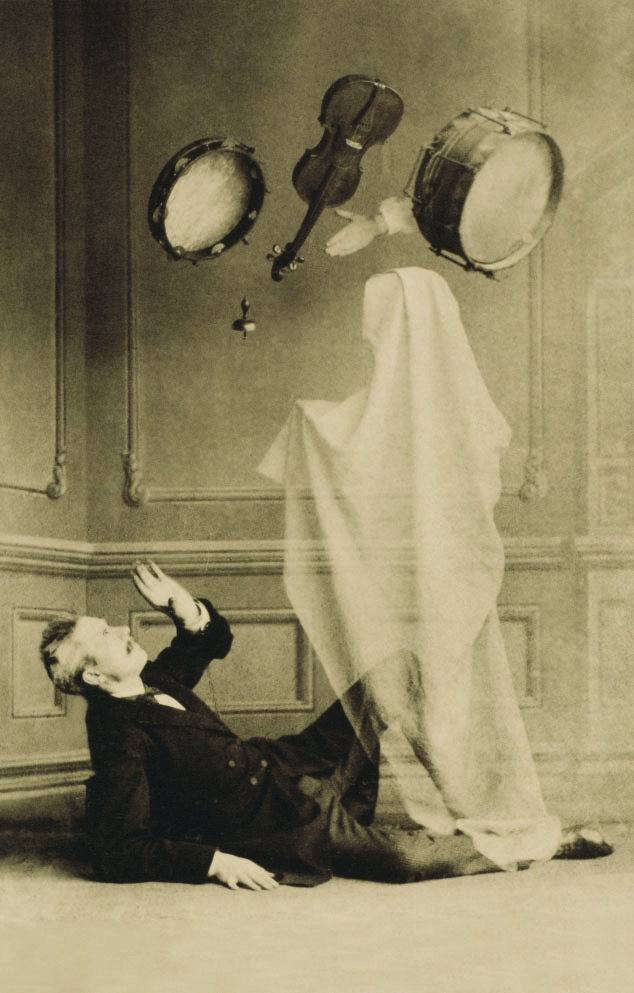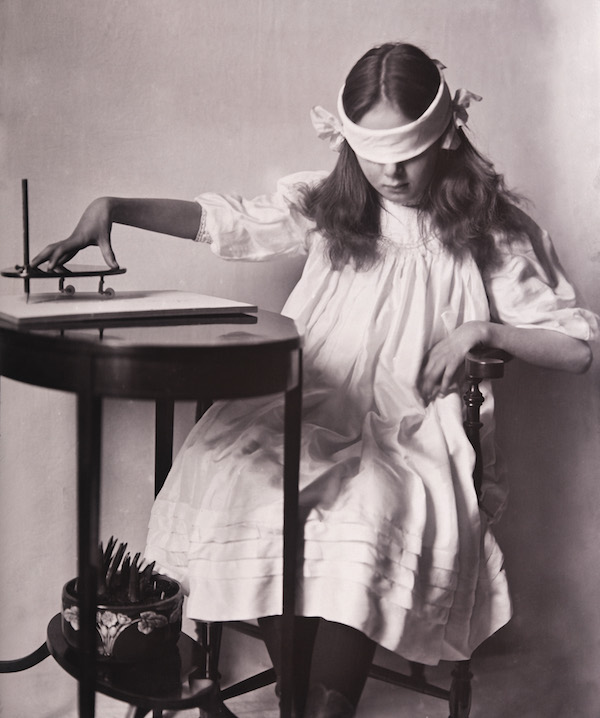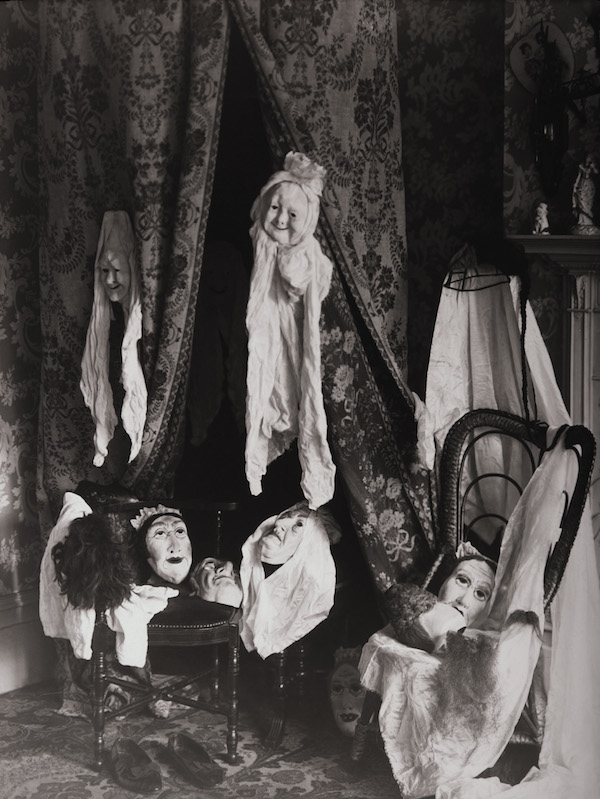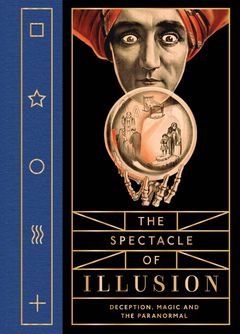
When Mystics and Mediums Convinced Scientists the Paranormal Was Normal
Matt Tompkins on People Who Talk to Dead People (and the People Who Study Them)
In the latter part of the 19th century, as so-called spiritualists and magicians clashed over the nature of the paranormal, members of the scientific community sought to establish methods for objectively addressing issues such as the possibility of thought transference and survival after death, alongside physical phenomena including apparitions and apports. Far from presenting a united front of enlightened skepticism, professional scientists confronted with spiritual and paranormal problems were often bitterly and dramatically divided. Although they sought to establish themselves as authorities on the empirical observation of the physical world, natural scientists were often unprepared for the problems associated with dealing with human subjects.
To appreciate how scientists became fascinated with spiritualism, and in some cases left themselves vulnerable to being manipulated by fraudulent mediums, it is useful to consider the tumultuous state of science and technology that existed at the turn of the 20th century. Again and again, researchers were uncovering invisible physical forces that had once been almost unimaginable. The scientific community embraced developments in radiation and electromagnetism; was it so much of a leap, some wondered, to consider emerging mediums such as the Fox sisters as a new sort of “spiritual telegraph”?
The physicist Sir Oliver Lodge conducted revolutionary research that had a major impact on the development of wireless telegraphy and radio; he was also a devoted spiritualist. He was convinced that, through mediums, he had repeatedly enjoyed direct communications with his dead son, Raymond. Lodge’s autobiography, published in 1931, provides a fascinating insight into his views on what he considered to be parallel scientific and mystical developments that he witnessed throughout his lifetime. He reminisced that he “had walked through the back streets of London . . . With a sense of unreality in everything around, an opening of deep things in the universe, which put all ordinary objects of sense into the shade, so that the square and its railings, the houses, the carts, and the people, seemed shadowy unrealities, phantasmal appearances, partly screening, but partly permeated by, the mental and spiritual reality behind.”
 Magician William S. Marriott stands in the background, ostensibly witnessing the emergence of a female apparition carrying a ‘spirit’ bird and flowers. This was one of many glass lantern slides used by psychic investigator Harry Price in his talks, to demonstrate the methods and equipment regularly used by fraudulent mediums at the time. Image from The Spectacle of Illusion, published by D.A.P. Courtesy of the Wellcome Library, London.
Magician William S. Marriott stands in the background, ostensibly witnessing the emergence of a female apparition carrying a ‘spirit’ bird and flowers. This was one of many glass lantern slides used by psychic investigator Harry Price in his talks, to demonstrate the methods and equipment regularly used by fraudulent mediums at the time. Image from The Spectacle of Illusion, published by D.A.P. Courtesy of the Wellcome Library, London.
In 1894, before the Royal Institute of London, Lodge revealed a new method for proving the existence of electromagnetic waves. Before a crowd of scientists, he demonstrated that he could wirelessly transmit an electrical signal from one end of the lecture theatre. The effect was simple: he created a spark in the front of the room, which caused a loud gunshot-like crack. For Lodge, the wireless trick was merely a convenient demonstration of the scientific principle of invisible “Hertzian waves.” It was left to the Italian inventor Guglielmo Marconi to recognize and capitalize on the enormous commercial potential of Lodge’s apparatus as a mechanism for wireless telegraphy. Marie Skłodowska Curie, a French-Polish chemist, likewise devoted time to investigating Eusapia Palladino, taking up the work following the death of her husband Pierre Curie, who had believed that Palladino’s mediumship might have been related to another mysterious unseen force: radioactivity.
The naturalist Alfred Russel Wallace (1823–1913) was a particularly controversial figure when it came to the science of spiritualism. Wallace rose to prominence as the co-discoverer, along with Charles Darwin, of the principle of natural selection. He rigorously promoted and defended the theory of evolution in the face of more conservative scientists. In 1876, Wallace sparked intense controversy when he invited the physicist William Fletcher Barrett (1844–1925) to read a paper on the topic of thought reading before the British Association for the Advancement of Science.
Wallace would eventually go on to assert not only that spiritualism was a legitimate topic for scientific investigation, but also that the reality of spiritualist phenomena was undeniable, given the number of reports from what he considered to be credible witnesses. He served as an expert witness in courtroom trials, speaking in defense of the legitimacy of mediums accused of fraud. This not only brought him into conflict with skeptical magicians such as John Nevil Maskelyne, but also Darwin, who was adamantly opposed to spiritualism. Wallace’s career was riddled with scientific controversies.
In addition to serving as an outspoken champion both of spiritualism and the theory of evolution, he also clashed publicly with the Flat Earth Society and campaigned against mandatory vaccinations. Barrett would go on to co-found a new scientific organization for the investigation of paranormal phenomena: the Society for Psychical Research (SPR). The SPR and its subsequent transatlantic counterpart, the American Society for Psychical Research, boasted many prominent scientists and intellectual figures, including the mathematician and writer Charles Dodgson (a.k.a. Lewis Carroll), Sigmund Freud, the founder of psychoanalysis, the American satirist Mark Twain, and many prominent early American psychologists such as Joseph Jastrow (1863–1944), G. Stanley Hall (1846–1924) and William James (1842–1910). Overall, SPR worked to legitimize scientific research into paranormal phenomena.
 German magician Jacoby-Harms (a.k.a. Hans Joachim Jacob Harms) appears to be overcome at the sight of airborne instruments in this 1866 image. Image from The Spectacle of Illusion, published by D.A.P. Courtesy of the Wellcome Library, London.
German magician Jacoby-Harms (a.k.a. Hans Joachim Jacob Harms) appears to be overcome at the sight of airborne instruments in this 1866 image. Image from The Spectacle of Illusion, published by D.A.P. Courtesy of the Wellcome Library, London.
Spiritualists used the reputations of sympathetic scientists and intellectuals to bolster the legitimacy of their beliefs, and they were eager to link spiritual phenomena with emerging technological advancements. Sir Arthur Conan Doyle, in discussing the Fox sisters and Daniel Dunglas Home, argued that a medium was “a telegraph instrument and telegraph boy united as one,” capable of receiving and delivering messages from our material world and the land of the dead. Spiritualists also argued that scientific methods and observations could never truly rule out the possibility that supernatural forces existed. Nicolas Camille Flammarion (1842–1925), a French astronomer and psychical researcher, offered a particularly vivid version of this argument. He asserted that not only was it plausible that “the spirits of the dead may survive, and wander to and fro, and hold communication with us,” but it was even “possible that we are surrounded by invisible non-human beings—gnomes, spirits and hobgoblins.” Science, he concluded, did not have the absolute right to reject any of these claims.
In America, the philosopher William James, today revered as the founding father of American psychology, became one of the leading proponents of SPR-style paranormal research. James’s best-known book, The Principles of Psychology (1890), is credited with helping to establish the study as a respected scientific discipline.
 This photograph from the collection of the magician William Marriott shows a young girl operating a planchette. Spiritualists claimed that mysterious external forces would guide the user’s hands, generating written messages. Early psychologists argued that the forces moving the planchette were unconscious muscle actions driven by the user’s mind. Image from The Spectacle of Illusion, published by D.A.P. Courtesy of the Wellcome Library, London.
This photograph from the collection of the magician William Marriott shows a young girl operating a planchette. Spiritualists claimed that mysterious external forces would guide the user’s hands, generating written messages. Early psychologists argued that the forces moving the planchette were unconscious muscle actions driven by the user’s mind. Image from The Spectacle of Illusion, published by D.A.P. Courtesy of the Wellcome Library, London.
His work is a fixture of modern-day experimental psychology courses. But many contemporary psychologists do not realize that James was also steadfastly sympathetic to psychical research. In addition to establishing the psychology department at Harvard University, he also served as the president of the American Society for Psychical Research (ASPR). He even declared that he had personally discovered at least one genuine spiritual medium, a Bostonian woman named Leonora Piper (1857–1950). In a speech delivered to the ASPR in 1896, James argued that it would only take one genuine medium to legitimize the scientific possibility of the survival of the human soul after death. He noted that “If you wish to upset the law that all crows are black, you mustn’t seek to show that no crows are; it is enough if you prove one single crow to be white,” and he declared that Leonora Piper represented his “white crow.”
Piper claimed that she could enter into a special trance state in which she was able to receive psychic messages from particular “spirit guides,” including a French physician named “Phinuit.” Her advocates came to believe that in some instances when Ms. Piper entered her trance, the spirit guides would take control of her voice, and at other times they would take control of her hand so that they could write messages. When in a trance, she would refer to herself as “the Machine” and sitters who wished to communicate with the spirits that she channelled were instructed to hold her hand up to their mouths and speak into it, as if she were a physical telephone. She would sometimes admonish sitters to speak more loudly into her hand, as if there were a bad connection and they were communicating over a great distance.
 Another example from Harry Price’s archive, this photograph shows props that disreputable mediums sometimes used. Seen here are masks, dummies, wigs and cheesecloth that might serve as ectoplasm. Unconvincing in the light, these would assume an altogether more impressive character in the tense atmosphere of a séance in a dark room. Image from The Spectacle of Illusion, published by D.A.P. Courtesy of the Wellcome Library, London.
Another example from Harry Price’s archive, this photograph shows props that disreputable mediums sometimes used. Seen here are masks, dummies, wigs and cheesecloth that might serve as ectoplasm. Unconvincing in the light, these would assume an altogether more impressive character in the tense atmosphere of a séance in a dark room. Image from The Spectacle of Illusion, published by D.A.P. Courtesy of the Wellcome Library, London.
Piper was a favorite subject for psychical researchers both in the USA and England, conducting hundreds of sittings with investigators that generated thousands of pages of transcripts. In some instances, she and her spirits would carry on after the death of her investigators. Following the death of the psychical researcher Richard Hodgson (1855-1905), who had conducted many sittings with Piper, the medium began to claim that she was speaking with the voice of his spirit. However, after her claim was tested extensively by psychologists Amy Tanner (1870-1956) and G. Stanley Hall, they concluded that “What was present of him, if anything, was not only fragmentary but incredibly stupid, oblivious and changed.”
Piper’s mediumship represents a particularly interesting case study, in that her most celebrated feats involved no physical phenomena. Nonetheless, skeptical critics have proposed a number of ways in which she may have acquired her uncanny insights through trickery. For example, the magician Martin Gardner (1914-2010) suggested that much of Piper’s apparently impossible knowledge may be attributable to techniques magicians refer to as “cold” and “hot” reading. Cold reading occurs when a performer, usually faced with an audience that he or she genuinely knows nothing about, can use a variety of rhetorical tricks to disguise a dialogue as a monologue. For example, a cold reader can present vague or ambiguous statements that listeners may interpret in specific ways. They can also reflect information gained from the audience back at them. A medium might open by vaguely stating that they sense that the sitter has recently lost someone (a fairly safe bet, given that the sitter has opted to visit a medium) and the sitter might respond that their mother recently died. Then the medium can confidently claim that “Yes, I can sense your mother’s presence here, very strongly.”
On paper, such techniques can sound trivial, but in emotionally charged circumstances, when the sitters are highly motivated, perhaps hoping to confirm their theory about life a er death or as a recently bereaved family member seeking reassurance, cold-reading tricks can become surprisingly powerful. Hot reading, by contrast, occurs when the performer is secretly able to gather information about their audience before the show, and then present that information as if they are magically learning it. In Piper’s time, other professional mediums were known to keep records of séance participants, lists of key information about them and those close to them (such as the names and ages of their recently deceased family members). These “blue books” were circulated among networks of fraudulent mediums. Thus, information revealed by a sitter at one séance might be “miraculously divined” later by another medium that the sitter might never have met in person before. Today, magicians and fake psychics can easily use social media to glean inside information about their audiences.
__________________________________

From The Spectacle of Illusion. Used with permission of DAP. Copyright © 2019 by Matt Tompkins.
Matt Tompkins
Dr. Matt Tompkins is an experimental psychologist and a professional magician. His new book The Spectacle of Illusion is now available for purchase in stores and online. Follow him on Twitter: @MattLTompkins http://matt-tompkins.com












